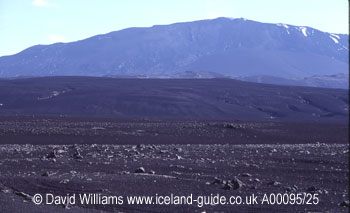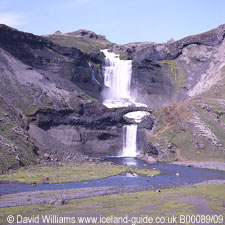 |
| This
is Hekla, Iceland`s most famous volcano. A light wisp of vapour is
given off from the summit crater and below it is a wasteland where
ash and lava have inundated the land. |
|
|
| The
waterfall Ófærufoss cascades into the eruption fissure
of Eldgjá. Unfortunately the natural bridge has collapsed since
this photograph was taken. |
Of all the
countries in the world, Iceland has possibly the most varied scenery for
such a compact area. Volcanoes, geysers, bubbling mudpools, glaciers,
deserts, mossy lavafields and verdant valleys — the country has all
of these on an island less than half the size of Britain.
Iceland was the last inhabitable outpost of Europe to be settled and since
the ninth century, the Vikings and their descendants have been at the
mercy of the twin threats of ice and fire. As if one or other of these
dangers was not enough, great volcanic eruptions under the ice-caps have
produced terrible catastrophes. One such volcano, Katla, can cause
a massive flood with a rate of flow greater than that of the River Amazon!
While previous generations were at the absolute mercy of these elemental
forces, today`s Icelanders have learned to live with the dangers and they
now exploit the natural wonders as tourist attractions. With few large
towns, virtually no pollution, wide open spaces and incredibly beautiful
scenery, Iceland is now becoming a fascinating tourist destination for
those seeking the peace and quiet so lacking in today`s world.
The uninhabited interior of the country dominates Iceland`s landscape
and greatly influences its climate. The interior is essentially a high
mountain plateau with extensive cold deserts and it is dominated by the
three main ice-caps Vatnajökull, Langjökull and
Hofsjökull. The ice-caps` glaciers erode the mountainsides
and the huge quantities of sand and gravel they produce form the deserts
and the large sandy areas ("sandur") that are so common along
the southern coast. Many visitors venture into the interior, though a
four-wheel drive vehicle is needed. Much of the interior`s landscape is
untouched by "civilisation" and there are fascinating places
to be seen, like Eldgjá, the world`s largest eruption fissure
within which is the waterfall Ófærufoss, which has
a natural bridge over the lower of its two falls.
Back
to the list of articles about this country
|

